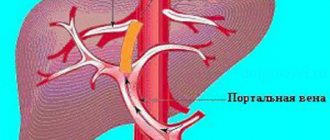Interestingly, a rather specific disease - arterial hypertension with pyelonephritis - occurs especially often among children of primary school age. 90% of recorded cases indicate that hypertension is combined with pathological changes in the kidneys. It is also detected in 42–54% of elderly hypertensive patients, and in 22% of patients with chronic renal failure.
Of course, experts consider these statistics to be approximate, since not all clinics conduct high-quality examinations; there may be many more patients.
Classification of the disease
There are two forms of nephrogenic hypertension:
- Vasorenal, or renovascular, - 30% of cases;
- parenchymal, or nephrosclerotic/renoparenchymal - 70% of clinical studies.
Vasorenal nephrogenic hypertension
Appears against the background of a violation of the integrity of blood vessels: atherosclerosis, thromboembolism, due to which the renal arteries narrow and the kidneys do not receive enough blood. It usually manifests itself as severe lumbar pain and increased pressure in the arteries of the kidneys.
Treatment involves only urgent surgery. According to the results of observations of specialists, pathology is established in 5% of patients with hypertension, in a third of them the disease is malignant, dynamically developing, accompanied by complications.
Parenchymal nephrogenic hypertension
The cause of this pathology is diffuse changes in the intrarenal vessels, nephrons and glomeruli: nephritis, initial glomerulonephritis, chronic pyelonephritis, more often at a young age, as well as nephropathy due to diabetes, vasculitis. As a result, the kidneys do not receive the required amount of blood.
Symptoms are expressed in:
- increased lower (renal) pressure, plasma in the blood;
- swelling due to water retention in the body, which leads to excess sodium (overhydration, hematuria);
- hormonal imbalances that inhibit the depressor function of the kidneys.
At the first stage of the disease, treatment can be carried out with medications: antihypertensive drugs and drugs to normalize kidney function. In advanced, severe forms, as well as in unilateral shrinkage of the kidney - chronic pyelonephritis - only an operation called nephrectomy is indicated. Late adoption of this measure is fraught with irreversible consequences:
- arteriosclerotic nephrosclerosis of the second, healthy kidney;
- uncompensated hypertension;
- further progression of pathologies even after removal of the affected kidney.
The reasons causing the above-described disorder may lie in both congenital and acquired kidney pathologies, sometimes in disturbances of regional circulation, the renin-angiotensive hormonal system (RAS), which is responsible for the level of pressure and blood volume. It is curious that in 43% of patients arterial hypertension is caused by bilateral chronic pyelonephritis than unilateral (35%).
So, let's summarize:
- hypertension of nephrogenic origin is preceded by inflammatory reactions of the kidneys, the first two weeks or several hours/days occur in latent or mild forms, but then the duration and severity of symptoms gradually increase;
- combination therapy helps only at the very beginning of the disease;
- in case of persistent, uncontrollable high blood pressure, nephrectomy should be resorted to.
It is also worth noting that the nephropathic form of hypertension during pregnancy occurs in the case of kidney intoxication due to the influence of the placenta on the female body or endocrine imbalance. It is determined by swelling, a stable increase in blood pressure and the number of plasma proteins in the glomerular capillaries of the kidneys.
Symptoms of joint flow
People with arterial hypertension and inflammation in the kidneys experience the following symptoms:
- Paleness of the skin.
- The fluid output is less than what is consumed.
- Tachycardia. A rapid, weak heartbeat occurs due to the narrowing of over-filled blood vessels.
- Increased blood pressure. Blood pressure is highest in the morning, because during the night a person secretes less fluid than during the day, and it accumulates, and the affected kidneys are not able to fully filter it.
- Scanty, frequent urination.
- Hands and feet are cold and wet. The cause of the symptom is narrowing of peripheral vessels. In this case, the blood supply to the limbs is disrupted, and fluid comes out through the pores.
Pyelonephritis and hypertension
It is traditionally believed that hypertension is a consequence of problems in the functioning of the cardiovascular system, the activity of which directly affects the level of blood pressure. In the vast majority of cases this is true.
But when it comes to renal hypertension, a slightly different relationship is observed.
- Hormonal. In order for the kidneys to function smoothly, appropriate blood pressure is necessary. A special hormone produced by the kidneys, renin, is responsible for the latter. As soon as the renal circulation slows down, it begins to be produced in large doses, resulting in its large-scale release into the blood. Renin then interacts with other hormonal and blood chemicals that constrict blood vessels or retain fluid in tissues. Thus, a disruption occurs in the blood circulation, which affects blood pressure.
- Immune. Chronic infectious kidney diseases, for example, pyelonephritis, which cause hypertension due to tissue inflammation and subsequent vascular damage, provoke a decrease in the production of depressor substances that regulate blood pressure. Thus, hypertension appears as a complication due to improper, untimely or insufficient treatment of the kidneys.
The general symptoms of investigative pathologies are:
- rapid deterioration of health;
- constant swelling;
- adding cardiac symptoms.
Thus, increased blood pressure is both an independent disease and a sign of protracted kidney disease and is investigative in nature.
Arterial hypertension due to pyelonephritis
In order for the kidneys to perform their functions normally, there must be a normal level of pressure in the vessels leading to them. This is why organs produce the hormone renin. It regulates the pressure indicator only if all processes are normal.
If blood flow in the kidneys decreases, then renin is produced in large quantities. It is able to interact with other hormonal substances that the body produces. And this interaction leads to vasoconstriction, fluid and sodium retention in the body.
As a result, blood circulation is disrupted and high blood pressure appears.
One of the causes of hypertension may be pronounced pyelonephritis. This inflammatory process leads to damage to the main structures of the organ, namely its vessels.
The tissues are depleted, as a result the processes through which depressor substances are produced are weakened. They are the ones who can reduce blood pressure.
All these pathological changes lead to persistent hypertension with kidney damage.
Quite often, stable hypertension in chronic pyelonephritis occurs due to an ischemic process in the kidneys, since vascular sclerosis is observed, which actively progresses.
It should be noted that in addition to the mechanisms of development of this pathology, which are described above, there may be other reasons for increased blood pressure with pyelonephritis:
- Coarctation of the aorta.
- Aneurysm localized on the renal artery.
- Atherosclerotic damage to the renal arteries, which can also lead to ischemic processes.
- Vascular embolism.
- Glomerulonephritis.
- Urolithiasis disease.
All this can not only cause pyelonephritis with high blood pressure, but also significantly aggravate the course of the pathology.
Relationship between pathologies
It should be noted that arterial hypertension is a complication of pyelonephritis. These conditions develop due to renal failure and nephroangiosclerosis. In acute pyelonephritis, hypertension does not manifest itself, only in chronic pyelonephritis.
Chronic pyelonephritis can be bilateral or unilateral. In both cases, arterial hypertension manifests itself. Sometimes it becomes malignant.
This means that blood pressure reaches quite high levels. A special feature is that the diastolic indicator increases significantly.
In addition to the progression of pyelonephritis, other complications are expected in the malignant course of hypertension.
An increase in blood pressure occurs during exacerbations of chronic pyelonephritis, or is chronic.
Features of the course of these joint pathologies are a sharp deterioration in the patient’s well-being, while swelling increases and cardiac symptoms increase.
The whole complexity of the combined course of pyelonephritis and hypertension lies in the difficulty of treatment, since conservative therapy is ineffective.
Symptoms
The symptoms of hypertension due to pyelonephritis are not much different from ordinary hypertension. There are cases when a person has no symptoms of kidney inflammation at all.
The most common signs are:
- Swelling of the face.
- Vomiting.
- A sharp deterioration in general health.
- Tremor of the limbs.
- Increased body temperature.
- The pain syndrome is localized in the lumbar region.
Bladder dysfunction will also occur. These include a frequent urge to urinate, and pain and burning will be felt. Also, the urine may change color, there may be an admixture of blood in it, and a pungent odor will appear.
If pyelonephritis occurs in a latent form, then the person will be bothered by nausea and vomiting, constant headaches localized in the back of the head, and dizziness. With minor physical exertion, shortness of breath and chest discomfort appear.
Such symptoms are most similar to hypertension, and if there are only such signs, then diagnosis is difficult. Sometimes patients experience lower back pain in addition to these symptoms.
With such a symptom, the doctor can already assume pyelonephritis during a preliminary physical examination.
Nephrogenic arterial hypertension can occur in several forms:
- Latent. This is a condition in which a person exhibits mild symptoms, weakness, and a systemic increase in body temperature and increased blood pressure.
- Recurrent. In this case, the disease in humans manifests itself in periods of exacerbations and remissions. Symptoms during exacerbation are pronounced: severe back pain, significant increase in temperature, urinary dysfunction, arterial hypertension, which is manifested by severe headache and dizziness.
- Hypertensive. This is a condition in which only the symptoms of hypertension are pronounced, and there are no signs of pyelonephritis. Symptoms include headaches, shortness of breath, cardiac asthma and cardialgia. Also, a common manifestation of this form of the disease is a hypertensive crisis, so quite often treatment is prescribed for hypertension, which means that the underlying pathology and cause of the symptoms are not eliminated.
- Anemic. This condition is manifested by anemic syndrome. Hypertensive symptoms are not expressed; a person may not even pay attention to them.
- Azotemic. This form is typical when there is already chronic kidney failure.
If renal hypertension is not treated on time, the condition may become more complicated and other symptoms may begin to appear. They indicate the following pathologies:
- Bacteriotoxic shock.
- Hypertension.
- Kidney and heart failure.
- Paranephritis.
Bacteriotoxic shock is a common complication of pyelonephritis, with a purulent lesion that develops very quickly. The pus contained in the organs is very toxic to healthy tissue. Quite often, such patients end up in the hospital, where they are given resuscitation measures.
Kidney failure is fairly easy to treat, and the process is reversible. When, as a result of this condition, the filtration capabilities of the kidneys are reduced, swelling, vomiting, severe pain in the back, and general weakness appear.
With paranephritis, a person will experience pain in the lumbar region, severe malaise, chills, high body temperature, and anemia develops.
This also results in increased blood pressure.
How does renal hypertension manifest?
Symptoms of nephrogenic hypertension are not always different from normal hypertension. However, the most common are the following:
- swelling of the body, face;
- poor appetite, urge to vomit;
- causeless fatigue, decreased performance;
- convulsions, involuntary trembling of limbs;
- temperature rise above 37 degrees;
- localized pain in the lumbar region;
- frequent painful (burning, stinging), sometimes bloody urination;
- change in the color and odor of urine.
Acute failure often occurs with purulent type of pyelonephritis. It is not only the pus in the organs that poses a threat to health, but also the composition of the substance. It contains toxic elements that provoke tissue breakdown and negatively affect healthy areas. The acute form of the disease does not develop immediately; it will take two to three days to manifest itself. The rate of occurrence and development of the disease depends mainly on how seriously the kidney tissue is damaged.
The diagnosis of “acute failure” in arterial hypertension is not scary. The kidneys are reversible in their structure and functions. Therefore, if the necessary means are used, they may well recover. Kidney failure can affect one kidney or both. An abscess may begin to develop in one of them. In order to restore the functioning of the tubule, it is necessary to reduce the load on these organs.
Treatment of the kidneys in this case consists of eliminating inflammatory processes, hemodialysis or hemosorption. With reduced filtration capabilities of the glomeruli, the patient experiences noticeable swelling, severe pain, and vomiting. The patient complains of general poor health, sometimes of a significant decrease in urine. Such pronounced symptoms allow the doctor, as a rule, to quickly and correctly diagnose and begin treatment.
The acute form of the disease can be completely cured, but even after good test results you should be careful about your health.
It is necessary to completely avoid some products that can affect organ tissue and alcohol. If you do not listen to the doctor’s recommendations and interrupt treatment, this will lead to complications and worsening of the situation.
Secondary paranephritis is a consequence of chronic pyelonephritis. Symptoms of the disease:
- heat;
- chills;
- malaise;
- severe pain in the lumbar region;
- anemia.
In addition to the above manifestations, the doctor sometimes notes the presence of high blood pressure. Paranephritis is a serious disease. As a result, purulent melting of the perinephric tissue occurs. It is possible to cure this form only after eliminating the causes of the general disease.
About mutual influence
Medical research shows that hypertension and pyelonephritis interact with each other in a vicious circle. Hypertension often develops against the background of kidney disease, and high blood pressure negatively affects the functioning of the paired organ. Under the influence of high blood pressure, damage to the vascular tissue of the kidneys occurs. As a result of this destructive process, the nutrition of the organ is disrupted, and renin is synthesized in increased volumes.
The main sign of the occurrence of nephrogenic hypertension is an increase in diastolic pressure, which is also called lower pressure. The degree of narrowing of the renal arteries plays an important role in the course of hypertension. If moderate vasoconstriction occurs, then doctors talk about a favorable prognosis for the disease, but with severe narrowing, we are talking about a malignant course of hypertension and a significant deterioration in kidney function.
Causes
Nephrogenic hypertension is provoked by almost all abnormal changes in the structure of the kidneys:
- hydronephrosis;
- tumors;
- tuberculosis;
- cysts;
- ischemia, sclerosis of renal vessels;
- urolithiasis;
- radioactive exposure.
But most often it is pyelonephritis - primary or secondary, which appears due to the development of diseases of other organs. It should be noted that in addition to the mechanisms of development of this pathology described above, there may be other reasons for increased blood pressure with pyelonephritis:
- coarctation of the aorta;
- aneurysm, atherosclerosis of the renal artery;
- vascular thromboembolism.
Symptoms of chronic pyelonephritis
Chronic pyelonephritis can be an outcome of acute (in 40-50% of cases with obstructive pyelonephritis, in 10-20% with gestational). It may develop gradually, gradually, often starting in childhood (more often in girls). The patient may not be bothered by anything or may have general complaints of weakness, increased fatigue, sometimes low-grade fever, chills (for a long time after a cold), possible aching pain in the lumbar region, pain in the right side with right-sided pyelonephritis, urinary disorders (polyuria or nocturia) , the appearance of pasty eyelids in the morning, increased blood pressure (hypertension is initially transient, then becomes stable and high).
Often the only symptoms of chronic pyelonephritis are:
- isolated urinary syndrome (minor bacteriuria, leukocyturia);
- reduced relative density of urine;
- anemia, difficult to treat (in the absence of signs of renal failure, it is caused by prolonged intoxication).
Sometimes latent chronic pyelonephritis first clinically manifests itself as symptoms of chronic renal failure. Pallor, dry skin, nausea, vomiting, and nosebleeds appear. Patients lose weight, anemia increases; Pathological elements disappear from urine. The rate of progression of chronic renal failure is determined by:
- activity of the infectious process;
- virulence of the pathogen;
- severity of hypertension and other factors.
In the absence of structural abnormalities and metabolic disorders, progression of the disease to end-stage chronic renal failure is rare (2-3%). The recurrent course of pyelonephritis leads to a decrease in kidney function much faster: 10 years after diagnosis, normal kidney function is observed in only 20% of patients.
An important role in the chronicization of the disease is played by disturbances in the passage of urine (vesicoureteral reflux, nephrolithiasis, etc.).
In elderly patients, the symptoms of chronic pyelonephritis can be varied - from oligosymptomatic or asymptomatic latent urinary infection, isolated intoxication syndrome, severe anemia to severe bacteremic shock with sudden collapse, signs of disseminated intravascular coagulation (DIC), septicemia, acute disorders of CBS. Urogenic acute pyelonephritis often immediately begins with the development of purulent inflammation.
The frequency of purulent forms, according to morphological studies, is close to 25% in men and 15% in women. Manifestations of intoxication may be accompanied by changes in the leukocyte formula and an increase in ESR. Differential diagnostic difficulties often arise when assessing the activity of the process in older people due to the fact that pyelonephritis develops or worsens against the background of multiple organ senile pathology, manifestations of systemic vascular diseases, tumor processes or metabolic disorders. In weakened cachectic patients, even purulent pyelonephritis, complicated by paranephritis, can be practically asymptomatic or manifested by intoxication syndrome and anemia.
Treatment
Most often, nephrectomy remains the only treatment that allows the patient to recover. But it does not completely guarantee this: final normalization of blood pressure after surgery is observed only in 50-65% of cases. This happens because by the time of the operation, pathological processes affecting the diseased kidney manage to affect the second one, causing various seals, thickening of the walls of its arterioles and small arteries. Target organs included in the cardiovascular system also suffer.
Surgery
Nephrectomy is the removal of a kidney with benign and malignant tumors through surgery.
Surgery is used when irreversible consequences that are dangerous to a healthy kidney or the health of the body as a whole begin or are highly likely to occur. And also when drug treatment does not bring positive results. The operation is effective in 75-80% of such cases. Then the second kidney coordinates its work and ensures homeostasis - self-regulation. In severe forms, when it can no longer be saved, a bilateral nephrectomy is performed followed by transplantation of a donor kidney.
In case of hypertension caused by calculous pyelonephritis, only the stone that caused inflammation is removed, after which systemic comprehensive treatment of the kidney and arterial hypertension is carried out. During this time, patients remain under the supervision of doctors in a dispensary.
Contraindications for surgery include:
- bilateral stenosis (narrowing) of the renal arteries;
- atherosclerosis of the neighboring kidney.
In order not to be mistaken in the correct choice of treatment method, PCBP is performed - a percutaneous biopsy of the opposite kidney using a puncture method (pierced with a special surgical instrument - a needle).
In addition, there are a number of surgical interventions:
- transaortic endarterectomy - removal of plaque in the lumen of the renal artery;
- removal of a narrowed section of the artery and its replacement with a lavsan graft or autovein;
- splenic-renal arterial anastomosis;
- extracorporeal surgery inside the parenchyma for renal aneurysm,
Allowing you to maintain and even restore normal blood circulation in the organ. The type of operation will depend on:
- type;
- location;
- degree of narrowing of the arteries of the kidney;
- extensiveness of the process (one- or two-way);
- the number and quality of surviving kidney nephrocytes.
The effectiveness of operations depends on the duration of the disease and the type of kidney damage, but not on the level of preoperative blood pressure.
Medication correction
At the first stage of the disease or as postoperative therapy, the doctor prescribes a set of drugs:
- hypotensive;
- antibacterial;
- corticosteroid;
- diuretic action.
Medicines remove pathogenic microorganisms and improve urine flow. A systemic therapeutic approach not only inactivates the inflammatory process, but also protects against the possible development of hypertension. For example, diuretics block beta-adrenergic receptors, which reduces the activity of juxtaglomerular cells that release excess renin, which is involved in the RAS, the system that controls blood pressure.
Diagnostics
The presented pathology is detected through complex diagnostics, which includes the following research methods:
- conducting laboratory tests of collected urine;
- urine culture to identify pathological microflora;
- various clinical urine tests;
- Ultrasound of the kidneys;
- performing cystography and cystoscopy;
- cystometry and examination by excretory urography;
- X-ray examination.
| Ultrasound |
|
| Analysis of urine |
|
What will happen if left untreated?
Lack of treatment usually leads to the transformation of pyelonephritis, as well as other renal infectious diseases, into chronic, sometimes purulent forms: paranephritis and subsequent bacteriotoxic shock. The following consequences are possible:
- persistent arterial hypertension;
- heart, kidney failure;
- increased intraocular pressure, which leads to complete or partial loss of vision - hypertensive retinopathy;
- heart attacks, strokes, disorders of the brain, lipid metabolism;
- changes in blood composition;
- low elasticity of the walls of blood vessels.
Symptoms of pyelonephritis during pregnancy
Acute pyelonephritis in pregnant women (including exacerbation of chronic pyelonephritis) occurs in approximately 10% of cases. Most often (about 80%) exacerbations develop in the second trimester (at a period of 22-28 weeks) of pregnancy, less often in the third trimester. Among the risk factors for the development of pyelonephritis during pregnancy, the most significant are:
- asymptomatic bacteriuria, untreated before pregnancy (30-40% of women);
- malformations of the kidneys and urinary tract (6-18%);
- stones in the kidneys and ureters (about 6%);
- reflux at various levels of the urinary tract;
- chronic kidney diseases, etc.
The development of gestational pyelonephritis is facilitated by urodynamic disturbances caused by pregnancy:
- hyperprogestinemia and associated hypotension, dilation of the pyelocaliceal system and ureters already in the early stages of pregnancy;
- pressure of the uterus on the urinary tract, which increases as pregnancy progresses;
- borderline and pathological variants of the course of pregnancy (large fetus, polyhydramnios, multiple pregnancy, narrow pelvis).
In the postpartum period, the risk of developing pyelonephritis remains high for another 2-3 weeks (usually on the 4th, 6th, 12th days after birth) while dilatation of the upper urinary tract persists. Acute pyelonephritis in pregnant and postpartum women is characterized by a sudden onset, high body temperature, chills, and severe intoxication. As the disease develops, the general symptoms of pyelonephritis are combined with local pain in the lumbar region on the affected side. If there is no effect from the therapy, further intensification of pain and increasing signs of intoxication, it is necessary to exclude purulent forms: apostematous nephritis, renal carbuncle, inflammation of the perinephric tissue. With these forms, the development of septic shock and acute renal failure is possible. Pyelonephritis in pregnant women can also occur with mild symptoms, the so-called “erased” form (especially in women who received antibiotic therapy during pregnancy), which makes diagnosing the disease difficult.
Prevention
Chronic bacterial infections of the kidneys and urinary tract are very difficult to cure completely, despite the capabilities of modern medicine. Therefore, the best means of prevention remains the classical method, consistent with the famous statement of E. Rotterdamsky, who says that a disease is easier to prevent than to treat. Both an overly scrupulous and negligent attitude towards one’s own health leads to problems with it. To avoid nephrogenic hypertension, the root cause diseases should be treated in a timely manner:
- genitourinary, urolithiasis pathologies caused by calculi - stones, other foreign elements;
- polycystic formations;
- prostatitis;
- traumatic injuries.
To do this you need:
- early diagnosis;
- compliance with prescribed treatment;
- compliance with hygiene rules;
- avoiding hypothermia, which leads to a decrease in the defenses of the immune system.
Prevention may also include measures to use folk remedies: herbal infusions, decoctions, suitable for each specific case.
Symptoms of kidney hypotension
The presented pathology may not manifest itself for a long time - the patient’s water balance in the body will not be disturbed, or disturbances in the process of urine discharge will not appear, which subsequently leads to difficulty in identifying the disease. Hypotension is often detected by ultrasound.
Kidney hypotension in a newborn is a congenital disease due to disturbances in the nervous regulation of the functioning of the bladder.
During this period, the baby experiences inadequate development of the muscular layer of the pelvis and a subsequent decrease in its tone. Little patients undergo a comprehensive examination several months after birth.
We will talk about methods of treating hypotension in this article on the site.
Diagnostics
The presented pathology is detected through complex diagnostics, which includes the following research methods:
- conducting laboratory tests of collected urine;
- urine culture to identify pathological microflora;
- various clinical urine tests;
- Ultrasound of the kidneys;
- performing cystography and cystoscopy;
- cystometry and examination by excretory urography;
- X-ray examination.
| Ultrasound |
|
| Analysis of urine |
|
Symptoms of kidney hypotension
The presented pathology may not manifest itself for a long time - the patient’s water balance in the body will not be disturbed, or disturbances in the process of urine discharge will not appear, which subsequently leads to difficulty in identifying the disease. Hypotension is often detected by ultrasound.
Kidney hypotension in a newborn is a congenital disease due to disturbances in the nervous regulation of the functioning of the bladder.
During this period, the baby experiences inadequate development of the muscular layer of the pelvis and a subsequent decrease in its tone. Little patients undergo a comprehensive examination several months after birth.
We will talk about methods of treating hypotension in this article on the site.
Hypertensive form of pyelonephritis
If treatment of the acute form of the disease is not completed, it can become chronic. The chronic form of pyelonephritis often occurs with sluggish symptoms that may not be noticed for a long time, considered unimportant, thereby triggering the disease and giving it the opportunity to spread deep into the kidney tissue. The chronic form of the disease causes renal hypertension.
Chronic pyelonephritis can affect either one or two kidneys at the same time. Symptoms of the disease can last for several years and completely modify this organ. With the help of modern methods and a properly selected treatment system, you can get rid of this disease and improve its course.











